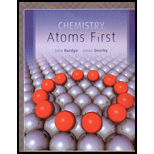
(a)
Interpretation:
Appropriate symbol for the given isotope has to be written.
Concept introduction:
Atoms having same
(b)
Interpretation:
Appropriate symbol for the given isotope has to be written.
Concept introduction:
Atoms having same atomic number but different mass number is known as isotope. The different mass number is due to the different number of total number of neutrons.
(c)
Interpretation:
Appropriate symbol for the given isotope has to be written.
Concept introduction:
Atoms having same atomic number but different mass number is known as isotope. The different mass number is due to the different number of total number of neutrons.
(d)
Interpretation:
Appropriate symbol for the given isotope has to be written.
Concept introduction:
Atoms having same atomic number but different mass number is known as isotope. The different mass number is due to the different number of total number of neutrons.
Want to see the full answer?
Check out a sample textbook solution
Chapter 2 Solutions
CHEMISTRY:ATOMS FIRST-W/ACCESS>CUSTOM<
 ChemistryChemistryISBN:9781305957404Author:Steven S. Zumdahl, Susan A. Zumdahl, Donald J. DeCostePublisher:Cengage Learning
ChemistryChemistryISBN:9781305957404Author:Steven S. Zumdahl, Susan A. Zumdahl, Donald J. DeCostePublisher:Cengage Learning ChemistryChemistryISBN:9781259911156Author:Raymond Chang Dr., Jason Overby ProfessorPublisher:McGraw-Hill Education
ChemistryChemistryISBN:9781259911156Author:Raymond Chang Dr., Jason Overby ProfessorPublisher:McGraw-Hill Education Principles of Instrumental AnalysisChemistryISBN:9781305577213Author:Douglas A. Skoog, F. James Holler, Stanley R. CrouchPublisher:Cengage Learning
Principles of Instrumental AnalysisChemistryISBN:9781305577213Author:Douglas A. Skoog, F. James Holler, Stanley R. CrouchPublisher:Cengage Learning Organic ChemistryChemistryISBN:9780078021558Author:Janice Gorzynski Smith Dr.Publisher:McGraw-Hill Education
Organic ChemistryChemistryISBN:9780078021558Author:Janice Gorzynski Smith Dr.Publisher:McGraw-Hill Education Chemistry: Principles and ReactionsChemistryISBN:9781305079373Author:William L. Masterton, Cecile N. HurleyPublisher:Cengage Learning
Chemistry: Principles and ReactionsChemistryISBN:9781305079373Author:William L. Masterton, Cecile N. HurleyPublisher:Cengage Learning Elementary Principles of Chemical Processes, Bind...ChemistryISBN:9781118431221Author:Richard M. Felder, Ronald W. Rousseau, Lisa G. BullardPublisher:WILEY
Elementary Principles of Chemical Processes, Bind...ChemistryISBN:9781118431221Author:Richard M. Felder, Ronald W. Rousseau, Lisa G. BullardPublisher:WILEY





